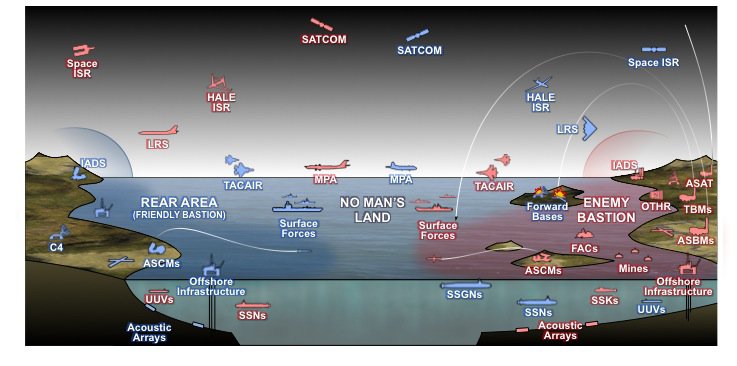
In several recent posts, I have alluded to something called the Third Offset Strategy without going into any detail as to what it is. Fortunately for us all, Timothy A. Walton, a Fellow in the Center for Strategic and Budgetary Assessments, wrote an excellent summary and primer on what it as all about in the current edition of Joint Forces Quarterly.
The Third Offset Strategy emerged from Defense Strategic Guidance issued by the President and Secretary of Defense in 2012 and from the results of the 2014 Quadrennial Defense Review. As Walton outlined,
The Defense Strategic Guidance (DSG) articulated 10 missions the [U.S.] joint force must accomplish in the future. These missions include the ability to:
– deter and defeat aggression
– project power despite antiaccess/area-denial (A2/AD) challenges
– operate effectively in cyberspace and space.
The follow-on 2014 Quadrennial Defense Review confirmed the importance of these missions and called for the joint force to “project power and win decisively” in spite of “increasingly sophisticated adversaries who could employ advanced warfighting capabilities.”
In these documents, U.S. policy-makers identified that the primary strategic challenge to securing the goals is that “capable adversaries are adopting potent A2/AD strategies that are challenging U.S. ability to ensure operational access.” These adversaries include China, Russia, and Iran.
The Third Offset Strategy was devised to address this primary strategic challenge.
In November 2014, then–Secretary of Defense Chuck Hagel announced a new Defense Innovation Initiative, which included the Third Offset Strategy. The initiative seeks to maintain U.S. military superiority over capable adversaries through the development of novel capabilities and concepts. Secretary Hagel modeled his approach on the First Offset Strategy of the 1950s, in which President Dwight D. Eisenhower countered the Soviet Union’s conventional numerical superiority through the buildup of America’s nuclear deterrent, and on the Second Offset Strategy of the 1970s, in which Secretary of Defense Harold Brown shepherded the development of precision-guided munitions, stealth, and intelligence, surveillance, and reconnaissance (ISR) systems to counter the numerical superiority and improving technical capability of Warsaw Pact forces along the Central Front in Europe.
Secretary of Defense Ashton Carter has built on Hagel’s vision of the Third Offset Strategy, and the proposed fiscal year 2017 budget is the first major public manifestation of the strategy: approximately $3.6 billion in research and development funding dedicated to Third Offset Strategy pursuits. As explained by Deputy Secretary of Defense Bob Work, the budget seeks to conduct numerous small bets on advanced capability research and demonstrations, and to work with Congress and the Services to craft new operational concepts so that the next administration can determine “what are the key bets we’re going to make.”
As Walton puts it, “the next Secretary of Defense will have the opportunity to make those big bets.” The keys to making the correct bets will be selecting the most appropriate scenarios to plan around, accurately assessing the performance of the U.S. joint force that will be programmed and budgeted for, and identifying the right priorities for new investment.
It is in this context that Walton recommended reviving campaign-level combat modeling at the Defense Department level, as part an overall reform of analytical processes informing force planning decisions.
Walton concludes by identifying the major obstacles in carrying out the Third Offset Strategy, some of which will be institutional and political in nature. However, he quickly passes over what might perhaps be the biggest problem with the Third Offset strategy, which is that it might be based on the wrong premises.
Lastly, the next Secretary of Defense will face numerous other, important defense challenges that will threaten to engross his or her attention, ranging from leading U.S. forces in Afghanistan, to countering Chinese, Russian, and Islamic State aggression, to reforming Goldwater-Nichols, military compensation, and base structure.
The ongoing conflicts in Afghanistan, Syria, and Iraq show no sign of abating anytime soon, yet they constitute “lesser includeds” in the Third Offset Strategy. Are we sure enough to bet that the A2/AD threat is the most important strategic challenge the U.S. will face in the near future?
Walton’s piece is worth reading and thinking about.
